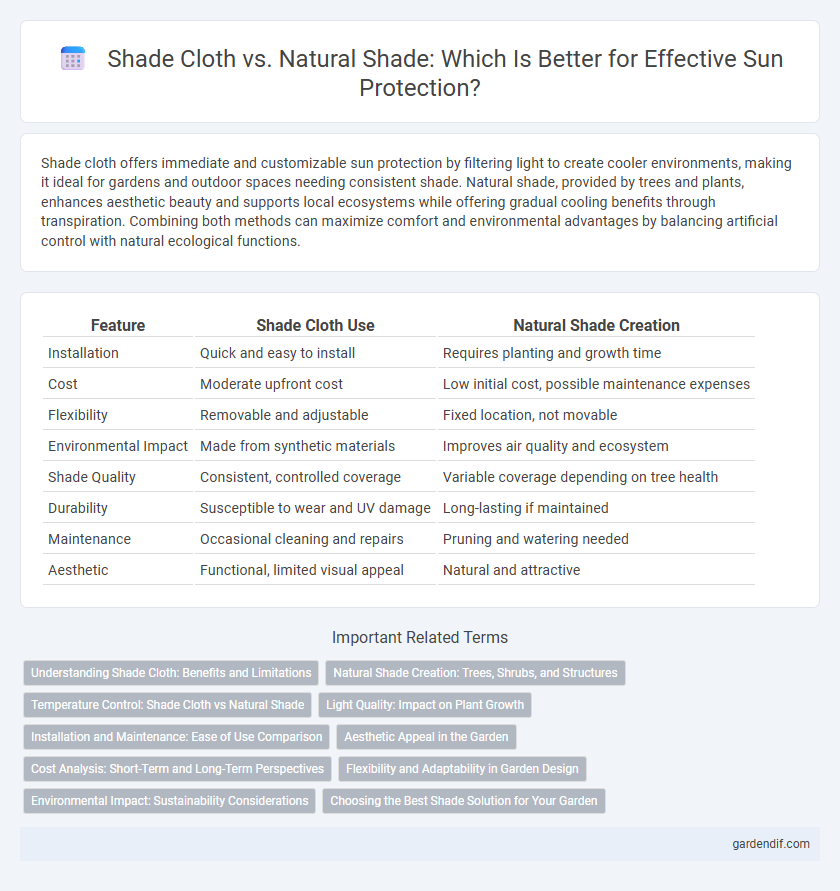
Shade Cloth Use vs Natural Shade Creation Illustration
Shade cloth offers immediate and customizable sun protection by filtering light to create cooler environments, making it ideal for gardens and outdoor spaces needing consistent shade. Natural shade, provided by trees and plants, enhances aesthetic beauty and supports local ecosystems while offering gradual cooling benefits through transpiration. Combining both methods can maximize comfort and environmental advantages by balancing artificial control with natural ecological functions.
Table of Comparison
| Feature | Shade Cloth Use | Natural Shade Creation |
|---|---|---|
| Installation | Quick and easy to install | Requires planting and growth time |
| Cost | Moderate upfront cost | Low initial cost, possible maintenance expenses |
| Flexibility | Removable and adjustable | Fixed location, not movable |
| Environmental Impact | Made from synthetic materials | Improves air quality and ecosystem |
| Shade Quality | Consistent, controlled coverage | Variable coverage depending on tree health |
| Durability | Susceptible to wear and UV damage | Long-lasting if maintained |
| Maintenance | Occasional cleaning and repairs | Pruning and watering needed |
| Aesthetic | Functional, limited visual appeal | Natural and attractive |
Understanding Shade Cloth: Benefits and Limitations
Shade cloth offers precise control over sunlight exposure, reducing heat and UV radiation while promoting plant health through adjustable light diffusion. Natural shade creation from trees provides ecological benefits such as habitat support and air quality improvement but lacks the customizable coverage and portability of synthetic materials. Understanding these differences helps optimize shading solutions for agricultural, horticultural, or outdoor living environments.
Natural Shade Creation: Trees, Shrubs, and Structures
Natural shade creation relies on strategically planting trees, shrubs, and erecting structures to provide sustainable and aesthetically pleasing shelter from sunlight. Trees such as oaks, maples, and elms offer extensive canopy coverage that reduces heat and blocks harmful UV rays, while shrubs add layered shade and improve microclimate conditions. Structural elements like pergolas and gazebos complement vegetation by creating consistent shade zones, enhancing outdoor comfort without the need for synthetic materials.
Temperature Control: Shade Cloth vs Natural Shade
Shade cloth provides consistent temperature control by blocking a specific percentage of sunlight, often reducing heat by up to 50%, which is crucial for protecting plants in extreme climates. Natural shade from trees creates variable cooling effects influenced by foliage density and transpiration, often resulting in localized temperature drops but less predictability. The microclimate under shade cloth tends to be more controlled and uniform, while natural shade offers additional benefits such as improved air quality and soil moisture retention.
Light Quality: Impact on Plant Growth
Shade cloth effectively reduces light intensity by filtering UV rays and diffusing sunlight, optimizing photosynthetic activity for diverse plant species. Natural shade from trees provides a dynamic light spectrum, including dappled sunlight, enhancing plant morphogenesis and nutrient uptake. Understanding the impact of light quality on chlorophyll synthesis and photomorphogenesis is crucial for maximizing growth and yield in both controlled and natural environments.
Installation and Maintenance: Ease of Use Comparison
Shade cloth installation offers straightforward setup with lightweight materials and customizable sizing, making it ideal for quick deployment and seasonal adjustments. Natural shade creation, relying on mature trees or shrubs, requires significant time investment and careful planning but demands minimal ongoing maintenance once established. Maintenance for shade cloth involves regular inspection for wear and cleaning to prevent mildew, whereas natural shade requires periodic pruning and pest management to sustain canopy health.
Aesthetic Appeal in the Garden
Shade cloth offers precise control over light filtration, allowing gardeners to achieve uniform shading that enhances plant aesthetics and protects delicate foliage. Natural shade creation, through strategically placed trees or tall shrubs, introduces organic textures and dappled light patterns that enrich the garden's visual appeal. Both methods contribute to a garden's atmosphere, but natural shade provides evolving seasonal colors and a dynamic living backdrop unmatched by synthetic solutions.
Cost Analysis: Short-Term and Long-Term Perspectives
Shade cloth installation offers an immediate, cost-effective solution with low upfront expenses and minimal maintenance requirements, making it ideal for short-term applications. Natural shade creation through tree planting involves higher initial costs due to planting and slower growth, but provides long-term environmental benefits, increased property value, and reduced energy expenses over time. Evaluating both options reveals shade cloth as the economical choice for immediate needs, while natural shade serves as a sustainable investment for future savings.
Flexibility and Adaptability in Garden Design
Shade cloth offers unparalleled flexibility and adaptability in garden design, allowing precise control over light exposure by adjusting fabric density and placement. In contrast, natural shade from trees or shrubs provides seasonal variation and ecological benefits but lacks instant modifications and repositioning options. Gardeners seeking tailored microclimates often choose shade cloth for its customizable protection against sun intensity, enhancing plant growth and comfort.
Environmental Impact: Sustainability Considerations
Shade cloth use reduces reliance on tree removal and preserves natural habitats, contributing to sustainable land management practices. Unlike natural shade creation that involves planting trees, shade cloth offers immediate, adjustable protection without long-term water or soil resources. This synthetic alternative minimizes environmental degradation and supports eco-friendly strategies in agricultural and urban settings.
Choosing the Best Shade Solution for Your Garden
Shade cloth offers precise control over light intensity, making it ideal for gardens requiring specific sunlight regulation to protect sensitive plants. Natural shade, created by strategically planting trees or shrubs, enhances biodiversity and provides long-term cooling benefits through evapotranspiration. Selecting the best shade solution depends on factors such as plant type, garden size, climate, and maintenance capabilities, ensuring optimal growth and energy efficiency.
Shade Cloth Use vs Natural Shade Creation Infographic

 gardendif.com
gardendif.com